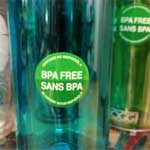 “BPA Junk Science Headaches,” by Angela Logomasini.
“BPA Junk Science Headaches,” by Angela Logomasini.
Could your affection for bottled water be responsible for your bout with migraines? Apparently so, if you believe the latest headlines about the chemical bisphenol A (BPA). But its wise to be wary of such silly claims.
First of all, it’s wrong to suggest that single serving bottled water commonly contains BPA, because that’s simply not true. BPA is not used for single-serving, flexible plastic water bottles, as pointed out on the International Bottled Water Association website. They note: “It [BPA] is not, however, used in any retail-sized PET bottled water containers.” Nor is it used for most food storage containers like GladWare and other more flexible plastic food storage containers. So go ahead and put those containers in the microwave and leave your bottled water in the car and sun despite the claims that doing so will release BPA! They don’t have any BPA to release. But even if they did, I wouldn’t worry.
BPA is used in the five-gallon water jugs designed for office water coolers, and other products made with hard, clear plastics, such as safety goggles. It was once used to make hard clear plastic reusable water bottles, but most of these are now made “BPA-free,” thanks to all the misguided hype about BPA risks. And BPA is used in resins that line the interior of soda cans and steel cans for canned foods. These resins prevent the development of dangerous pathogens in our food, which is a good thing! The trace levels of of BPA that ends up in the food are so low that the risks are negligible and those benefits outweigh any risks, as numerous comprehensive scientific reviews around the world have concluded.
But “news reporters” and environmental activists are not interested in the full body of research showing BPA risks are negligible. They rather focus on the random, small study that is often little more than junk science.
In the latest BPA “study,” now featured in news headlines, researchers injected a handful of rats with a solution containing a concentrated level of BPA. These rodent exposures were hundreds — if not more than a thousand – times higher than what humans experience from food packaging. Then the researchers watched the animals to see if they appeared to have headaches. After being injected with high levels of BPA, the rodents “demonstrated decreased locomotion, exacerbated light and sound aversion, altered grooming habits, and enhanced startle reflexes,” according to the study. We don’t know for sure if this behavior resulted from migraines–or some other adverse effect. But the researchers concluded that the BPA caused migraines. Hence, the news stories carried headlines like: “More Bad News for Plastic Bottles: BPA Causes Migraines [Study].” Note that this story pictures of a woman drinking from a bottle that is not made with BPA-based plastic. But when it comes to BPA “news,” the facts apparently don’t matter.
If you think this is a really ridiculous study, you’re right!
It’s not only dumb because the exposure levels are not relevant to trace exposures common among humans, but because humans also do not have BPA injected into their organs. Rather we consume minuscule amounts in food, which our bodies easily metabolize and pass out in our urine. Rats, on the other hand, don’t metabolize BPA very well and in this case, they were essentially poisoned with the BPA via injection. It’s no wonder they were agitated! I’d be agitated too, wouldn’t you?
If anything, this study is little more than gratuitous torture for these poor creatures. And that was made possible thanks in part to a federal grant from the National Institute of Health. Your tax dollars at work!




















